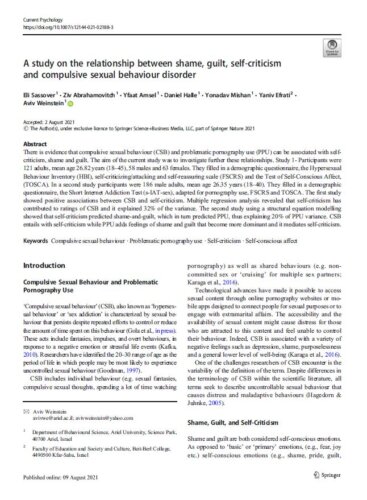Mental Health
A study on the relationship between shame, guilt, self-criticism and compulsive sexual behaviour disorder
Open Access: No.
Abstract
There is evidence that compulsive sexual behaviour (CSB) and problematic pornography use (PPU) can be associated with self-criticism, shame and guilt. The aim of the current study was to investigate further these relationships. Study 1- Participants were 121 adults, mean age 26.82 years (18–45), 58 males and 63 females. They filled in a demographic questionnaire, the Hypersexual Behaviour Inventory (HBI), self-criticizing/attacking and self-reassuring scale (FSCRS) and the Test of Self-Conscious Affect, (TOSCA). In a second study participants were 186 male adults, mean age 26.35 years (18–40). They filled in a demographic questionnaire, the Short Internet Addiction Test (s-IAT-sex), adapted for pornography use, FSCRS and TOSCA. The first study showed positive associations between CSB and self-criticism. Multiple regression analysis revealed that self-criticism has contributed to ratings of CSB and it explained 32% of the variance. The second study using a structural equation modelling showed that self-criticism predicted shame-and-guilt, which in turn predicted PPU, thus explaining 20% of PPU variance. CSB entails with self-criticism while PPU adds feelings of shame and guilt that become more dominant and it mediates self-criticism.
Relevance
The study showed a “positive correlation: between self-criticism and shame and compulsive sexual disorder (which can include “spending a lot of time watching pornography”).
Those with problematic pornography use had “significantly higher levels” of self-criticism as well as shame and/or guilt.
Citation
Sassover, E., Abrahamovitch, Z., Amsel, Y., Halle, D., Mishan, Y., Efrati, Y., & Weinstein, A. (2023). A study on the relationship between shame, guilt, self-criticism and compulsive sexual behaviour disorder. Current Psychology, 42, 8347–8355. https://doi.org/10.1007/s12144-021-02188-3

